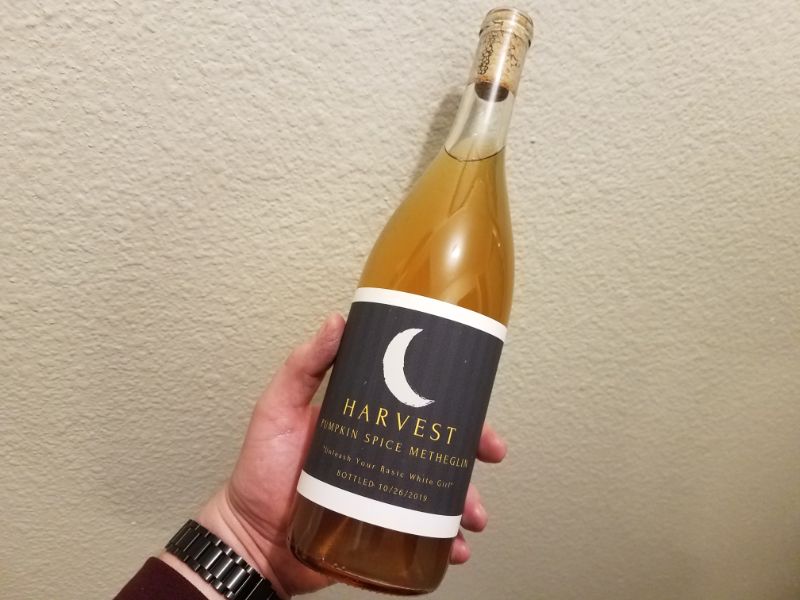My first true metheglin, a pumpkin spice mead.
Originally Posted: Sept. 24, 2020

Table of Contents
Quick Specs
- OG = ~1.120 (after step-feeding, apple juice, and maple syrup)
- ABV: ~15-16%
- Taste Profile: Pumpkin spice-y
- Time: 8/24/19 – 10/26/19 (63 days)
- Yield: 29 bottles
Intro
When Autumn comes around, I’m one of those people that likes spiced foods and drinks. This extends to my pumpkin soup recipe, pumpkin spice lattes, and pumpkin spice beers. While I was in mead-making mode, I had often wondered what a pumpkin spice mead would be like, so one day I decided to finally try and make one.
There were some sediment complications from using canned pumpkin, but in the end I was left with 29 bottles of very tasty and strong mead. This mead was also my first real metheglin (spiced mead). I had read that metheglins can be over-spiced sometimes, and unlike fruit, the spice flavor never really ages out. The solution to over-spicing a metheglin turned out to be a vodka-spice tincture, added to taste right before bottling.

Ingredients
- 5 lbs. Canned pumpkin (next time I make this, I’ll roast some pie pumpkins instead)
- 3 lbs. Sliced sweet potatoes (as a source of amylase)
- 32 oz. Trader Joe’s Grade B Maple Syrup
- Pumpkin pie spice vodka tincture (just before bottling)
- 5 lbs. Kirkland Clover Honey
- 10 lbs. Solimo Wildflower Honey (5 lbs. initially and 5 lbs. a week or so later)
- 15 lbs. of honey total. I think this recipe would also be good with all Buckwheat Honey, but the amounts above were just leftover honey I had sitting around
- Enough spring water to top off to about 7 gallons
- 1/3 tsp. Amylase blend
- Yeast nutrient
- 3 Tbsp. Pumpkin pie spice (for spice tincture)
- Vodka (for spice tincture)

Equipment


Instructions
- Caramelize the 5 lbs. of canned pumpkin (or your sliced pumpkin or kabocha) by roasting in the oven for an hour. You can sprinkle some of the pumpkin spices and mix in a bit of the maple syrup if you wish, but you’ll have more control over the spice flavor if you add them right before bottling. I only added a little at this stage to get an idea of the aroma I was going to end up with.
- Optional: Do a sort of “mini-mash” (to borrow from beer terminology) of the caramelized pumpkin with the sliced sweet potatoes and amylase enzyme at 150 – 155°F (66°C – 68°C). My aim was to use the amylase powder and the naturally occurring amylase from the sweet potatoes to extract some flavor and sugars from the pumpkin, for a more “authentic” feel in my end product.
- Add pumpkin/sweet potato mixture to fermenter along with 10 lbs. of warmed honey, pectic enzyme, and yeast nutrient. Top off with enough spring water to come to 6 – 7 gallons (you can change the volume based on your fermenter size or your desired ABV).
- If there is a lot of sediment (canned pumpkin option): Rack mead into secondary fermenter, leaving behind any sediment. Top off with apple juice if necessary and add remaining 5 lbs. of honey and 32 oz. of Grade B maple syrup. If there isn’t much sediment, you can skip the apple juice.
- Ferment to desired dryness/strength.
- Make a spice tincture by mixing 3 Tbsp. pumpkin pie spice in a mason jar and filling the rest of the way with vodka. Shake to mix. This tincture can be strained after a few days and stored for use in later beers/meads.
- When it’s time for bottling, mix in a tablespoon or two of spice tincture at a time, stir, and taste. When you get a flavor you like, write down how much you added so you can save time next time.
- Due to the spices, you’ll always have a little sediment in your bottles. I don’t recommend filtering or fining this mead at all once the spices have been added, as you’ll lose that spice flavor.


Variations
The only thing I can think of doing differently next time is to use a sliced pie pumpkin or kabocha instead of canned. This will help with sediment issues, though amylase penetration and flavor/sugar extraction might suffer a little. Then again, they say that most of the “pumpkin flavor” in all things pumpkin-spice comes from the spices rather than the pumpkin.
Tips & Tricks
Topping off with apple juice is a great way to remedy losing a lot of mead to sediment. Since apple juice ranges from 1.035 to 1.045 SG, you’re already close to the SG range of 1 lb. honey to 1 gallon of water. This saves on the amount of extra honey you’ll need to add, and saves you the time of weighing out the honey.
Possible Culinary Uses
So far, I’ve only used this as a deglazing liquid in my pumpkin sausage soup recipe. It adds a nice richness to the soup.
It could also be good in a braised pork recipe, and I’m sure there’s a number of dessert recipes it could be used as an ingredient in.




